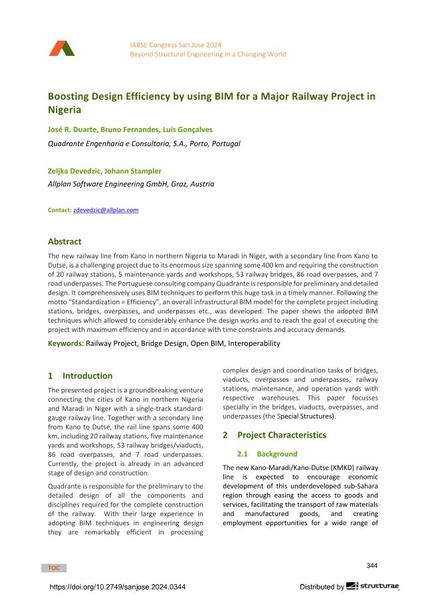Boosting Design Efficiency by using BIM for a Major Railway Project in Nigeria

|
|
|||||||||||
Bibliographic Details
| Author(s): |
Jose R. Duarte
(Quadrante Engenharia e Consultoria, S.A., Porto, Portugal)
Bruno Fernandes (Quadrante Engenharia e Consultoria, S.A., Porto, Portugal) Luís Gonçalves (Quadrante Engenharia e Consultoria, S.A., Porto, Portugal) Zeljka Devedzic (Allplan Software Engineering GmbH, Graz, Austria) Johann Stampler (Allplan Software Engineering GmbH, Graz, Austria) |
||||
|---|---|---|---|---|---|
| Medium: | conference paper | ||||
| Language(s): | English | ||||
| Conference: | IABSE Congress: Beyond Structural Engineering in a Changing World, San José, Cost Rica, 25-27 Seotember 2024 | ||||
| Published in: | IABSE Congress San José 2024 | ||||
|
|||||
| Page(s): | 344-351 | ||||
| Total no. of pages: | 8 | ||||
| DOI: | 10.2749/sanjose.2024.0344 | ||||
| Abstract: |
The new railway line from Kano in northern Nigeria to Maradi in Niger, with a secondary line from Kano to Dutse, is a challenging project due to its enormous size spanning some 400 km and requiring the construction of 20 railway stations, 5 maintenance yards and workshops, 53 railway bridges, 86 road overpasses, and 7 road underpasses. The Portuguese consulting company Quadrante is responsible for preliminary and detailed design. It comprehensively uses BIM techniques to perform this huge task in a timely manner. Following the motto “Standardization = Efficiency”, an overall infrastructural BIM model for the complete project including stations, bridges, overpasses, and underpasses etc., was developed. The paper shows the adopted BIM techniques which allowed to considerably enhance the design works and to reach the goal of executing the project with maximum efficiency and in accordance with time constraints and accuracy demands. |
||||
| Keywords: |
bridge design interoperability open BIM Railway Project
|
||||
